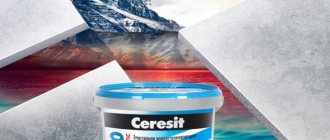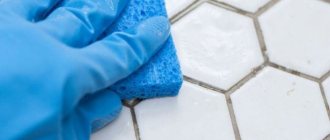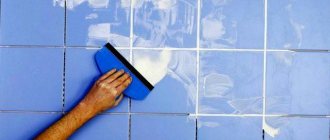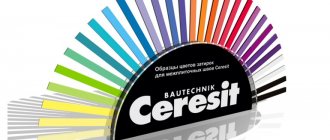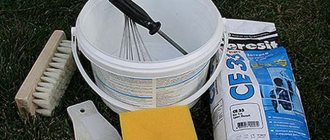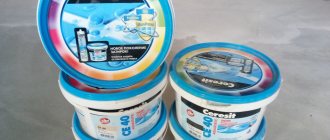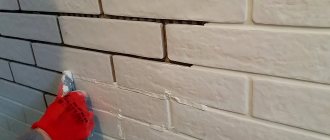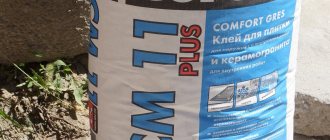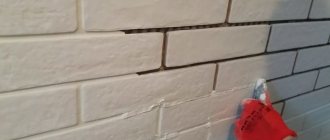When tiling horizontal and vertical surfaces with ceramic, stone, artificial and other types of tiles, the final stage of work is always grouting. The main purposes of grout are:
- Protecting the adhesive mastic or cement-sand mortar on which the tiles are laid from the ingress of water and aggressive substances: for example, alkali contained in soap and detergents.
- Preventing contamination of seams and the emergence of conditions for the proliferation of harmful microorganisms in them - fungus or mold.
- Bringing the lined surface to a finished aesthetic appearance.
One of the recognized manufacturers of building materials is the German company Henkel, which produces tile grout under the Ceresit trademark on the production lines of its branch factories in Eastern Europe, including the Russian Federation.
Features of Ceresit grout
Many are familiar with the products of this brand and have already appreciated their quality. Ceresit brand grouts have the following properties:
- Rich palette of shades:
- Protection against fungus and mold;
- Waterproof
It is important to take into account that when drying, the shade of the seam becomes lighter. To make a choice in favor of one color or another, you need to look at the samples displayed in the store, and not at the jar label.
Famous brands
Experts note that the best materials for processing tile joints include the following brands:
- Kiilto;
- Mapei;
- Anserglob;
- Baumit;
- Mira.
Among the companies producing repair materials, one of the leading ones is Henkel Bautechik. The company's product range includes a line of tile grouts called “Ceresit”.
Scope of application of Ceresit grout
Grouts perform not only a decorative function. Thanks to special components in the composition, they protect the masonry from moisture and prevent the formation of fungus. They also help to better hold the tiles in place.
Ceresit products are suitable for various surfaces that cannot be deformed: plaster, concrete, screed. At the same time, not only ceramic cladding, but also stone and glass can act as a finishing material.
There are Ceresit grouts for interior work. For example, for filling the seams between the floor and the wall, which act as a sealant. Such compositions have their own markings and are not suitable for outdoor use.
Rules for selecting shades
Experienced craftsmen do not believe that the colors of tiles and grout should be identical. On the contrary, a darker or lighter shade is visually more attractive.
When decorating a space with tiles with a bright pattern, it is recommended to use transparent grout, because... it will not distract attention from the main print.
Types of Ceresit grout
Ceresit offers a wide range of grouts for different tasks. In order not to make a mistake with your choice, you need to know the characteristics of different types of mixtures.
- Ceresit CE 33 Super is used to fill the narrowest joints up to 5 mm. It should be chosen for tiles laid almost end-to-end. It has antibacterial components and is frost-resistant. The palette includes 26 shades.
- Ceresit CE 35 Super is suitable for cladding laid at intervals of 4 to 15 mm. Convenient when working with stone. The color scheme consists of 5 five shades. By adding an elasticizer, it can be used for a swimming pool.
- Ceresit CE 43 Super Strong. Has increased strength and ductility. This brand has a wide range of applications, it is suitable for joints of 5-20 mm. Contains elasticizers and does not crack even on wide seams. Available in nine colors.
- Ceresit CE 40 Aquastatic. Suitable for indoor and outdoor use. As the name suggests, it has good water-repellent properties, so it can be used in swimming pools and saunas. Designed for filling joints up to 10 mm. You can choose from 37 shades.
- Ceresit CE 79 UltraPox. This grout is usually chosen when working with mosaics, including transparent ones, stone, clinker tiles and other expensive materials. It lies neatly and is securely attached to the surface.
- Ceresit CS 25. It is used as a sealant at the junction of plumbing fixtures and walls or floors. Not afraid of household chemicals and sunlight. At the same time, its palette is quite diverse - 24 shades.
- Ceresit CT 10 Super. Maximum protection of seams from moisture and mold. Available only in transparent form.
Material consumption
The consumption of the composition, depending on the size of the tile, is 0.4-0.5 kg per 1 square meter of area.
When using dry Ceresit grouts on external surfaces, the manufacturer always recommends additionally using water-dispersed silicone impregnation CT 10 , which increases the resistance of joints to negative temperatures, the effects of precipitation and biological contaminants.
Liquid silicone grout CS 25 is best applied using a special piston dispenser gun. Epoxy composition CE 79 is most often used on horizontal surfaces. When mixing the components, you must strictly follow the instructions included in the package, otherwise rinsing and re-grouting may be necessary.
When using these types of Ceresit grouts on vertical surfaces, treatment of the seams begins from top to bottom. In liquid form, excess can be removed with organic solvents such as alcohol or acetone. After the compositions have completely set, only mechanical cleaning is possible, so for greater accuracy, it is better to first protect the edges of the tiles with tape.
Technical characteristics of Ceresit grout
For different types of Ceresit grout, the technical characteristics are slightly different. Let's give an example - the most popular grout with a rich range of colors, CE 33.
It is obtained from cement, mineral fillers, polymer modifiers and various dyes.
When using the mixture, the following data is taken into account:
- Per kilogram of mixture – 0.32-0.33 liters of water;
- The density of the resulting mixture is 1.75 kg/dm3;
- Consumption – from 60 minutes;
- Frost resistance – more than 100 cycles;
- Grout can be used at temperatures from 5 to 300C;
- Not flammable
This mixture has high plasticity, withstands heat and cold, and is easily applied to seams. It is also important that Ceresit grouts are environmentally friendly. When the seams dry, they don't sculpt anything, so you don't have to worry about harmful fumes.
Best time to work
Grouting of joints, seams and gaps must be done after the mortar used to cover the surface has completely hardened. Each brand of Ceresit has its own shelf life, but it is at least a week.
Grouting work must be carried out in the following sequence:
- Clean the edge of the material from contamination.
- When working with an old surface, completely remove the previous grout.
- Better adhesion is achieved by wetting the edge of the material with a damp sponge.
- Prepare the mixture strictly in accordance with the instructions for this Ceresit model.
- While working, use gloves and goggles that protect your skin and eyes.
- Work in a well-ventilated area.
Calculation of Ceresit grout per 1 m2
The packaging contains all the necessary information that allows you to calculate the material consumption.
The following formula is also used for calculations.
- The sum of width and length is calculated.
- Divided by their derivative.
- The resulting figure is multiplied by the thickness and width of the seam.
This way you can get the grout consumption in kilograms used per square meter.
Reviews
Durable grout for small joints. I used it for tiles in the bathroom, for the sixth year now the tiles are like new. Not a single crack or chip, the main thing is to mix and apply correctly.
Vladimir Kartashenkov, 42 years old: “I bought the grout along with the tiles on the advice of my friend the master. For the blue floor in the kitchen, I chose a dark blue mixture, because the light solution darkens unevenly over time. Among the advantages of Ceresit CE 33 I would like to note its easy dilution and low price. A small minus is the packaging, which is quite fragile due to the thin paper.
” Ruslan Nurmagomedov, 33 years old: “I was doing renovations in the bathroom, and when the time came to choose a grout, I decided to trust the consultant in the store and settled on Ceresit CE 33. My intuition did not let me down: the mixture turned out to be easy to use, I was able to easily wash it off the surface . The mortar holds well in the seams; nothing has come off in a year. The only thing I didn't like was the rather complicated breeding.
” Sergey Kuteynikov, 24 years old: “If you follow the operating instructions and mixing proportions, Ceresit CE 33 solution will be the ideal completion of the laid tiled cladding. All that remains is to choose a store and, if necessary, contact a grouting specialist.”
Choosing Ceresit grout color
When starting to choose a shade, everyone can show their imagination and choose the product they like.
Still, here are some generally accepted recommendations from tile laying experts:
- Using white grout is acceptable in most cases. If you don't know what color to choose, just go with white.
- Traditionally, darker shades are used for flooring, since keeping light-colored joints perfectly clean will be problematic.
- Light seams create a more complete picture and the design of the room looks unified, while dark seams, on the contrary, make the space fragmented.
The rule that light shades expand space also works with grout. For cramped bathrooms, this is an important factor, so light tiles with light grout will help solve this problem, at least visually.
Color palette
Henkel pays special attention to the color component of grout mixtures. The basic colors include three dozen colors of Ceresit grout, but the palette is constantly expanding by adding more complex shades (for example, mint or caramel).
Of course, buyers most often choose white grout; it is a classic that goes well with any tile. The remaining shades will help if you want to create a contrasting design or create the illusion of a uniform surface. Dark colors are often chosen for flooring, as the floor gets dirty quickly and regularly.
Different lines of mixtures offer a different set of color solutions. If you need to choose a special shade for a joint, the easiest way to do this is to use Ceresit CE 40 grout; The colors in her palette include 38 tones in the natural range. Thanks to the use of the Color Perfect formula, the mixture provides a smooth surface and rich color that is durable and resistant to fading.
Source vanna-expert.ru
The Ceresit palette includes several similar shades of gray, beige, and blue. This helps to more accurately select the color of the grout mixture, especially when the ceramics are patterned and include several tones. The choice of Ceresit grout color has some nuances that cannot be ignored:
- To obtain the declared color, you must strictly adhere to the manufacturer's instructions. A common mistake: the shade turns out lighter and the seam is spotty if you wash the tiles with a poorly wrung out sponge. Excess moisture over-wets the seam and washes out the color pigment.
- There is no black color in the line. “Graphite” and “Anthracite” are shades of dark gray.
- To ensure the color matches the sample, use a clean container and tool for kneading, and do not violate the proportions indicated in the instructions. The shade will become paler if you add a little more water.
Source dekoriko.ru
About the natural palette of Ceresit CE 40 grout in the following video:
Tips for use
For best results, follow the manufacturer's recommendations:
- Apply grout when the cladding is completely dry; in the case of a cement-sand mixture, you will have to wait a week;
- If there are residues of grease, glue and other contaminants on the tiles, they must be removed;
- You can mix a little mixture by hand, but for large volumes you should use a mixer or drill with an attachment, stirring at a speed of 400-800 rpm;
- Wait a technological break for 5 minutes and stir the grout again;
- Before filling, you can run a damp sponge along the seam, this will help the compound adhere better;
- When replacing old grout with a new one, the remaining mixture must be thoroughly cleaned - all seams must have equal depth;
- For 24 hours, protect the filled joints from sunlight, overheating, wind, and another week from rain if the work was done outside.
Like other Ceresit products, the grout of this German brand has long gained popularity among consumers. Correct selection and proper use of Ceresit grouts allow you to obtain excellent results.
Product purpose
German manufacturers, as always, are particularly scrupulous. Among the brands are mixtures for processing gaps with thicknesses:
- Up to five millimeters;
- From four to fifteen mm;
- Up to twenty millimeters;
- Silicate grout, ideal for filling joints between tiles and plumbing fixtures.
Photo of ceresit grout (ceresit)
Storage and shelf life
If the grouting material is stored in a warehouse, it should be placed on pallets. Damaged packages are not permitted for storage. The grout shelf life established by the manufacturer is 2 years.
If the dry mass remains after the work, then the packaging should be tightly closed and stored in a dry, dark place.
